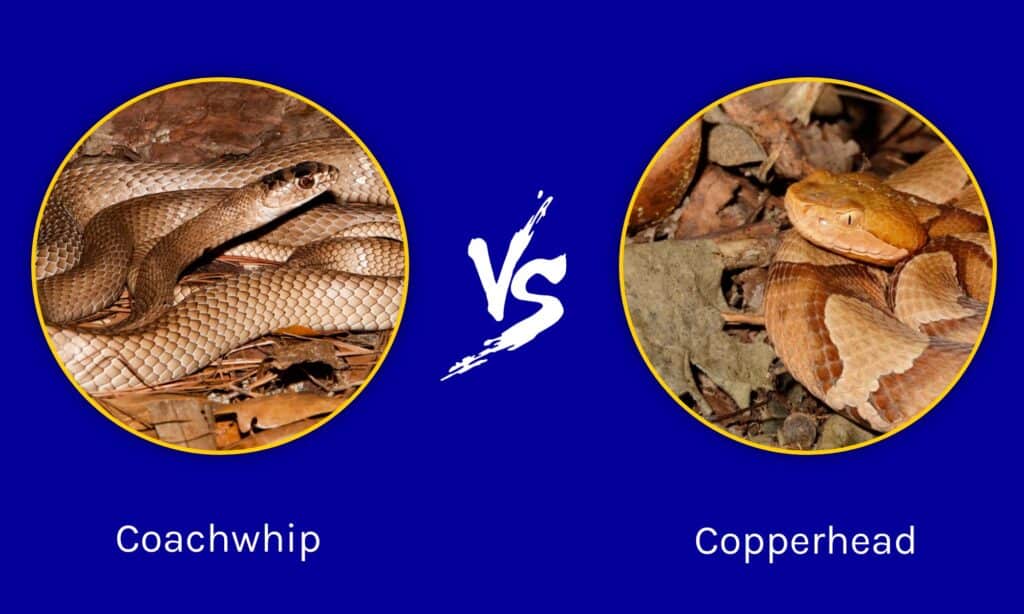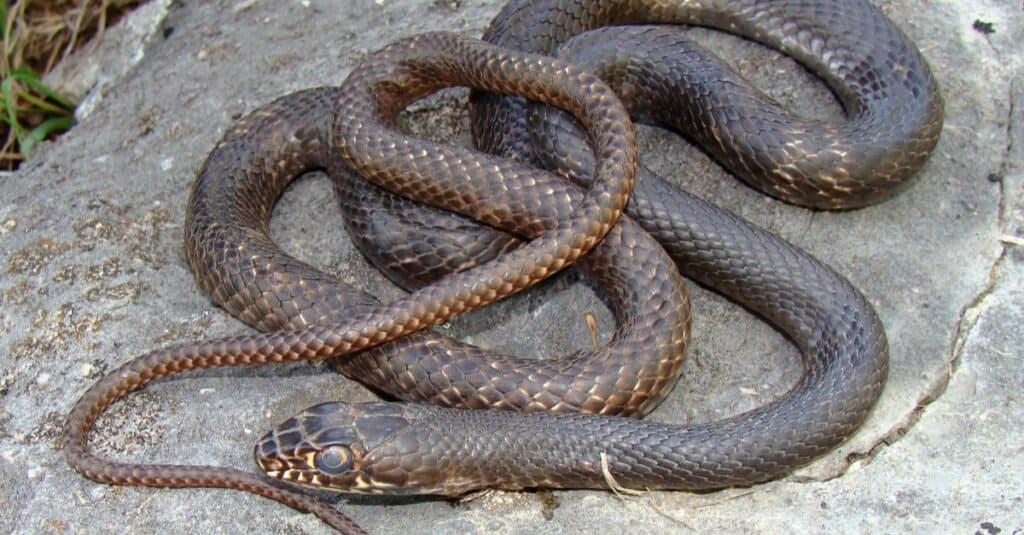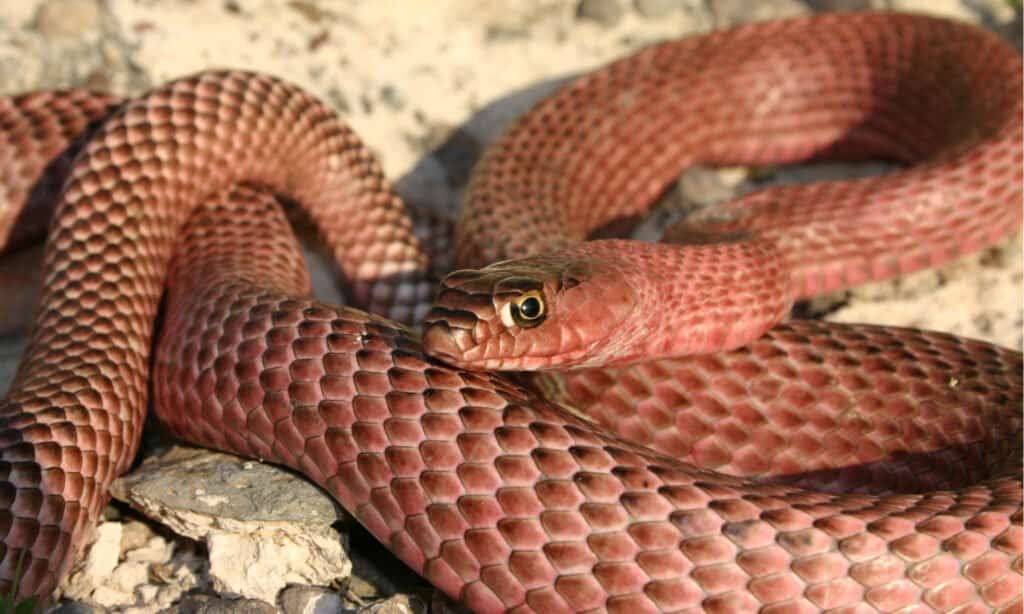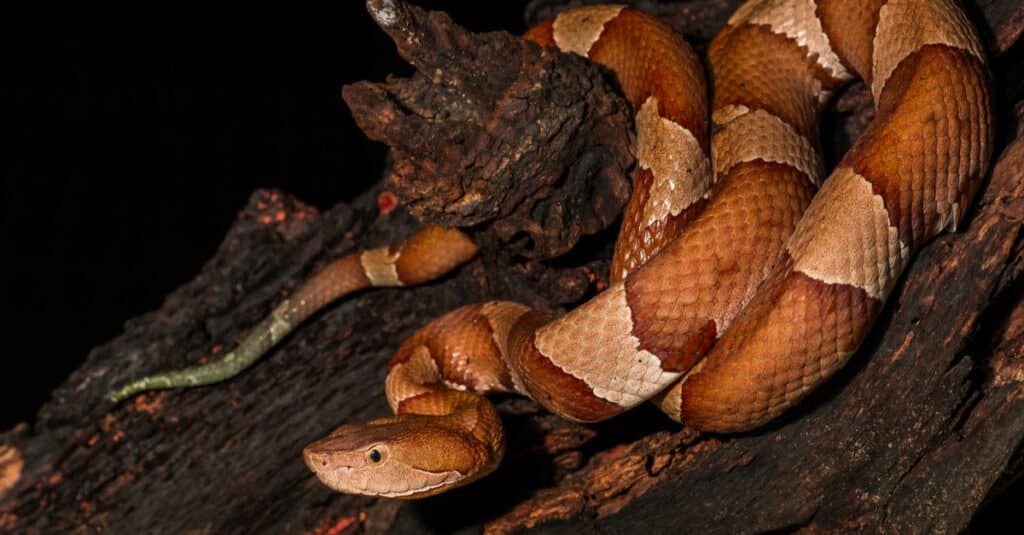Both the coachwhip snake and the copperhead live in the southern United States with slightly varying ranges in the north, south, and along the Mississippi River. A coachwhip snake is 8 feet long while a copperhead only grows up to 4 feet. What are some other differences when it comes to a coachwhip vs copperhead?
It’s good to know what to look for since the two of them have overlapping territories. This makes it easy to encounter both kinds of snakes. Understanding the differences will allow you to deal with a snake confrontation appropriately.
Let’s get down to business and see how a coachwhip snake differs from a copperhead.
Comparing a Coachwhip Snake and a Copperhead

| Coachwhip | Copperhead | |
|---|---|---|
| Length | Up to 8 feet | Up to 4 feet |
| Venomous | No | Yes |
| Origin of Name | Scale Patterning | Color |
| Speed | Up to 4 mph | Up to 2 mph |
| Pupils | Round | Cat-Eye |
| Lay Eggs | Yes | No |
| Asexual Reproduction | No | Yes |
| Playing Dead | Yes | Yes |
| Pursue Prey | Yes | No. Waits to strike |
| Make Good Pets | No | No |
Important Differences with a Coachwhip Snake vs Copperhead

Coachwhip snakes are nonvenomous.
©Matt Jeppson/Shutterstock.com
The important differences and similarities between a copperhead snake and a coachwhip are listed below.
- Coachwhip snakes grow up to 8 feet long whereas copperheads only get half that size.
- They generally live in the same range, though there are minor differences.
- Coachwhip snakes are nonvenomous whereas copperheads are venomous.
- Coachwhip snakes have a tapering color on their bodies while copperheads have color-blotched rings.
- Coachwhip snakes got their name from their scale patterning while copperheads got their name from their color.
- Coachwhip snakes can move up to 4 mph whereas pit vipers like copperheads average 2 mph.
- Copperhead snakes have narrow cat-eye pupils whereas coachwhips have round pupils.
- Copperheads give live birth whereas coachwhips lay eggs.
- Coachwhips cannot reproduce through asexual reproduction, but copperheads can.
- Both snakes will play dead and emit a musk as a last resort, though how they go about this is a little different.
- Coachwhips pursue prey whereas copperheads lie in wait to strike.
- Coachwhip snakes and copperhead snakes share much of the same diet. Copperheads can eat bigger things because of their size.
- Both snakes are terrible to keep as pets.
Coachwhip Snake vs Copperhead: Venom

Copperhead snakes are venomous.
©Jeff W. Jarrett/Shutterstock.com
Coachwhip snakes are nonvenomous whereas copperheads are highly venomous. Their venom doesn’t pose much of a threat to humans though. Their first bite, although painful, usually contains no venom and is meant to ward off the intrusion.
It’s important to note that copperhead bites are the most common snake bite in America. Most of the time, they hide so well that people don’t notice them and step on them.
A copperhead’s venom doesn’t work on some kingsnakes, opossums, or skunks. This has piqued the interest of the scientific community, and more research is being done to study this phenomenon.
Coachwhip Snake vs Copperhead: Appearance

Copperhead snakes have cat-eye pupils.
©Creeping Things/Shutterstock.com
Coachwhip snakes are one solid gradient of color without any designs in that coloration. Their tails are generally white, while their heads are dark brown or black. This can vary by region, with some variations being red or pink in color.
A coachwhip’s scales are textured in such a way that they look like a braided whip which is where they got their name. Copperhead bodies are a solid color with no gradient covered in almost banded blotches that are darker than the body. They are named after their copper-colored appearance, so both snakes get their names from their looks.
Copperheads also have cat-eyed pupils, whereas coachwhips have eyes with round pupils.
Copperheads have bulky triangular heads with pits on either side by their nostril whereas coachwhip snakes have small heads that are not triangular. Coachwhips lack the heat-sensing pits on either side of their face. These pits are why the copperhead is a pit viper.
Coachwhips are among the snakes that are mistaken as copperheads in high adrenaline situations out of fear. However, with a little understanding of their coloration, it’s easy to tell them apart.

Coachwhip snakes have round pupils.
©Nathan A Shepard/Shutterstock.com
Coachwhip Snake vs Copperhead: Speed
Coachwhip snakes are one of the fastest snakes found in the Americas, moving up to 4 mph. Pit vipers only move at about 2 mph, so a coachwhip can outrun a copperhead. That and their differing lengths sometimes put copperheads on the coachwhip’s menu.
Coachwhip Snake vs Copperhead: Reproduction

Copperhead snakes give birth to live young.
©Wildvet/Shutterstock.com
Coachwhip females mate with several different males in the spring and summer. They then lay about 11 eggs in a burrow. On the other hand, female copperheads are ovoviviparous, so they let their eggs hatch inside of them before they give live birth.
Copperheads have a longer gestation period than coachwhips. Copperheads can give birth without a male in a process called parthenogenesis.
Coachwhip Snake vs Copperhead: Playing Dead
Coachwhip snakes will play dead if warnings and aggression don’t work to deter a threat. Copperhead snakes aren’t as quick to play dead nor are they as dramatic about the show, but they’ll still go limp if excessively handled.
Copperheads will release a musk much like the coachwhip before they resort to playing dead. This musk comes out of their cloaca, which is the same hole used for bodily waste and reproduction. Their musk is more pleasant to smell than the coachwhip’s, though both are inherently disgusting as designed.
Coachwhip Snake vs Copperhead: Hunting
The coachwhip snake and the copperhead snake have two different hunting styles. Coachwhip snakes actively pursue their prey and hold them in their jaws until they die. Copperheads bite their prey after staying very still and allowing the venom to kill the animal. Both snakes swallow their prey whole.
Coachwhip Snake vs Copperhead: Diet
Coachwhip snakes and copperheads both enjoy a similar carnivorous diet. They primarily eat lizards, rodents, and insects.
The cicada emergence in 2021 led people to speculate if cicada populations caused larger populations of copperheads. While more copperheads showed up at the cicada snack bar, it is uncertain whether this increases the number of copperheads in the area. It may just mean they all come out for the cicada feeding.
Both snakes will cannibalize their young if they must. They’ll also happily eat other kinds of snakes that are in the juvenile stage or otherwise smaller than them. On the flip side, copperheads and coachwhips will also be dined upon by snakes that are larger than them at any point in their lives.
Coachwhip Snake vs Copperhead: Keeping as Pets
Copperhead snakes make terrible pets. While they can be gentle if acclimated to handling, they need a large enclosure and still pose the threat of a venomous bite. Coachwhips are only good pets for the most experienced handler because they’re prone to biting and are not easily tamed.
The photo featured at the top of this post is © Nathan A Shepard/Shutterstock.com
Discover the "Monster" Snake 5X Bigger than an Anaconda
Every day A-Z Animals sends out some of the most incredible facts in the world from our free newsletter. Want to discover the 10 most beautiful snakes in the world, a "snake island" where you're never more than 3 feet from danger, or a "monster" snake 5X larger than an anaconda? Then sign up right now and you'll start receiving our daily newsletter absolutely free.
Thank you for reading! Have some feedback for us? Contact the AZ Animals editorial team.






